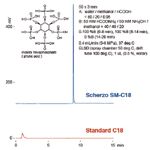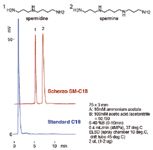Improved Resolution and Retention of Highly Acidic and Highly Basic Molecules Using Scherzo SM-C18 Multi-Mode Column
Imtakt USA
Bhavana Verma and Itaru Yazawa, Imtakt USA
Highly charged basic and acidic compounds are analyzed in many different fields and industries, including the fields of biochemistry, food chemistry, and pharmaceuticals. It is difficult to retain and resolve these types of compounds on a standard C18 HPLC column. In order to overcome these separation challenges, Imtakt Corporation has introduced the Scherzo SM-C18 column, which has a novel multi-mode stationary phase containing anion, cation, and C18 ligands. The very acidic molecule inositol hexaphosphate (phytic acid) and the very basic molecules spermine and spermidine are retained much better by the Scherzo SM-C18 column than by a standard C18. In addition, although many multi-mode HPLC columns suffer from weak batch-to-batch reproducibility, the Scherzo SM-C18 column shows excellent reproducibility for a range of pharmaceutical compounds.
Experimental
All data was generated with a semi-micro HPLC system equipped with ELSD detection. Inositol hexaphosphate (phytic acid) was eluted on a Scherzo SM-C18 column of dimensions 50 mm × 3 mm (see Figure 1). Gradient elution was utilized with a flow rate of 0.4 mL/min, column temperature of 37 °C, and pressure of 50–60 bar.

Figure 1: Elution of inositol hexaphosphate (phytic acid).
Spermine and spermidine were eluted on a Scherzo SM-C18 column of dimensions 75 mm × 3 mm (see Figure 2). Gradient elution was utilized with a flow rate of 0.4 mL/min, column temperature of 37 °C, and pressure of 40 bar.

Figure 2: Elution of spermine and spermidine.
Results and Discussion
The Scherzo SM-C18 multi-mode HPLC column easily retains highly charged basic/acid compounds that are not retained on a standard C18 column. This column can also recognize slight structural differences: the very similar spermine and spermidine were well resolved on the Scherzo SM-C18 column, while they coeluted on a standard C18 column. Not only does the Scherzo SM-C18 exhibit excellent resolution and retention, it also shows great batch-to-batch reproducibility for a wide range of small molecules, offering significant advantages for method development.
Imtakt USA
1315 Walnut Street, Suite 619, Philadelphia, PA 19107
tel. (888) 456-HPLC, (215) 665-8902, fax (501) 646-3497
Website: www.imtaktusa.com; Email: info@imtaktusa.com

The Benefits of Custom Bonded Silica
April 1st 2025Not all chromatography resins are created equal. Off-the-shelf chromatography resins might not always meet the rigorous purification requirements of biopharmaceutical manufacturing. Custom bonded silica from Grace can address a wide range of separation challenges, leading to real performance improvements. Discover more about the latest innovations in chromatography silica from Grace, including VYDAC® and DAVISIL®.
5 Things to Consider When Selecting a Chromatography Silica
April 1st 2025Particularly in the pharmaceutical industry, drug purity isn’t just a goal – it’s essential for achieving safety, stability and efficacy. However, purification is easier said than done, especially with challenging molecules like DNA and RNA “oligonucleotides,” due in large part to their diversity and the range of impurities that can be generated during production. Enter DAVISIL® chromatographic silica, with a wide range of pore diameters and particle sizes to meet your specific application, performance and sustainability requirements. Before you choose the chromatography resin for your next purification application, take a look at these 5 considerations.
Automating Protein Purification: Efficiency, Yield, and Reproducibility
March 27th 2025Recent advancements in automated protein purification stress the importance of efficiency, scalability, and yield consistency. This eBook compares different purification platforms, highlighting their impact on downstream applications and demonstrating how automation enhances throughput and process control.
MilliporeSigma: Ultrapure Water for Sensitive LC-MS Analysis of Pesticides
March 25th 2025The aim of the study was to illustrate the efficiency of Milli-Q® water purification systems in eliminating pesticides from tap water, thereby producing and delivering reliable and consistent-quality ultrapure water suitable for pesticides analysis














